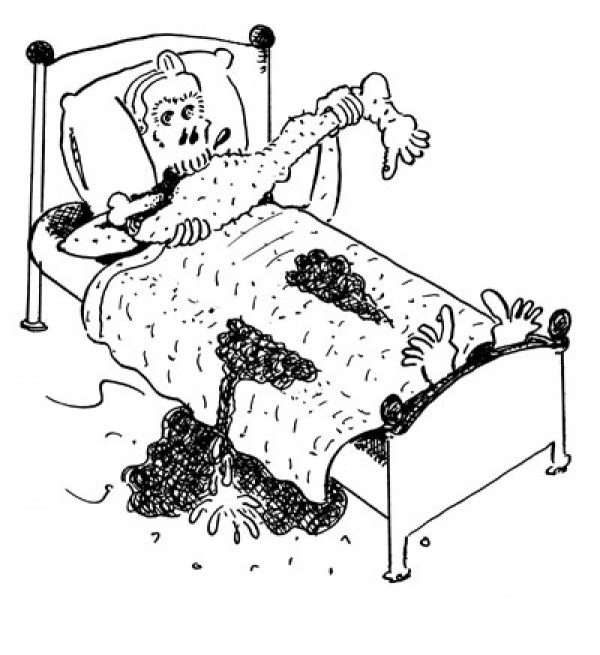I’ve always heard that a notable number of serial killers were bed-wetters. I could never figure out what correlation there could be in any outside-of-TV-land reasoning, besides maybe crazy parents having more ammo for shaming their prepubescent killers-to-be. Is there any truth to it? My neighbors have five kids, four of whom still wet the bed, and I want to get a head start on whom to run the hell away from. —Angel
Now, Angel. In an age of random mayhem, surely you can see the value in identifying future criminals. Let’s assume there are two million adult Americans with some history of bed-wetting (rough estimate) and 100 serial killers currently at large (very rough estimate), and that all SKs are former BWs (untrue—I’m saying let’s assume). That would mean the little pack of misfits next door, if they don’t grow out of it, collectively would have a 1 in 5,000 chance of producing the next John Wayne Gacy. True, if you’re working in the PreCrime division in Minority Report, or even just writing papers for the criminology journals, that hardly qualifies as pinpoint accuracy. But at least we’d have narrowed it down.
Or we would if there were any basis for the claimed correlation. However, despite the fact that the idea has been kicking around in academia for more than 70 years and has now become entrenched popular belief, odds are it’s complete crap.
Bedwetting has often been linked to antisocial tendencies, mostly as part of an unholy triad of behavioral disorders: enuresis (bed-wetting), fire-setting, and animal abuse. Drawing a connection between urination and fire goes back at least to Jonathan Swift and in modern times got a boost from Freud: “It is as if primitive man had had the impulse when he came in contact with fire, to gratify an infantile pleasure ... and put it out with a stream of urine ... [representing] a sexual act with a man, an enjoyment of masculine potency in homosexual rivalry,” he wrote in 1930. “It is remarkable how regular analytic findings testify to the close connection between the ideas of ambition, fire, and urethral eroticism.”
Others took this notion and ran with it. A 1940 paper linked bed-wetting with fire-setting and cruelty to animals. In 1963, psychologist John Macdonald tied all three to those making homicidal threats, in the process lending his name to the supposed correlation, now often called the “Macdonald triad.” In a 1986 book Macdonald upped the ante, saying those with the triad plus messed-up parents “figure prominently in the ranks of serial murderers,” a notion elaborated on by later researchers.
Evidence for the triad’s predictive power has always been thin. MacDonald provided no data in his 1963 paper and in a later followup concluded the triad didn’t reliably predict homicide.
The most commonly-cited empirical support for the triad comes mostly from a 1966 study by Daniel Hellman and Nathan Blackman. They found that of 31 prison inmates convicted of violent crimes, 45 percent exhibited the triad and 74 percent showed at least one of the three behaviors, much higher than for nonviolent criminals. In particular, 68 percent of the violent criminals had been bed-wetters versus 28 percent of a group of nonviolent criminals.
That’s interesting, but we’re only talking about a few dozen subjects. What’s more, from the case studies, it’s apparent the violent criminals had so many other bad things going on (abusive parents, personality disorders, mental problems) that it’s difficult to see why you’d attach any great significance to bedwetting, or to the triad generally. Nonetheless, Hellman and Blackman proposed the triad as a “pathognomonic sign”—when you saw it in a kid, it was a cinch they’d grow up to be trouble.
That conjecture subsequently hardened into the conventional wisdom, not just in the mind of the public fed the usual baloney by Hollywood, but among professionals in the field. It was left to a criminology grad student writing a master’s thesis to make the case that the triad was an urban legend. In her 2009 paper, Kori Ryan pointed out that:
• Little research on the triad as such had been done, although it was frequently mentioned in the professional literature.
• Studies looking at the individual triad behaviors were more numerous but were often beset by methodological problems.
• “The limited empirical research that does exist is not sufficient to support the contention that [the triad] portend[s] later violence,” much less serial murder.
The same could be said of bed-wetting specifically, and Ryan suggests recent researchers haven’t taken it too seriously as a presager of bad things—and really, why should they? Chronic fire-setting and animal cruelty are deliberate antisocial behaviors; whether or not they’re the mark of a future psychopath, they’re not a healthy sign.
Bed-wetting, on the other hand, is involuntary, and plainly was included in the triad mostly because of half-baked psychoanalytic notions. It’s also fairly common, affecting something like 1 to 2 percent of those 15 or older, the vast majority of whom aren’t criminals. To suggest it’s a sign of a future serial killer—excuse me, that’s just wrong.
Send questions to Cecil via StraightDope.com or write him c/o Chicago Reader, 350 N. Orleans, Chicago 60654.
More by Cecil Adams
-
This Is the End, My Friend
This week's Straight Dope marks the last appearance of the column as the Teeming Millions have known it for the past 45 years.
- Jul 11, 2018
-
Do Brain Supplements Do Anything?
Brain Drain
- Jul 4, 2018
-
Is flying really worse for the environment than driving?
Planes and Trains
- Jun 27, 2018
- More »




